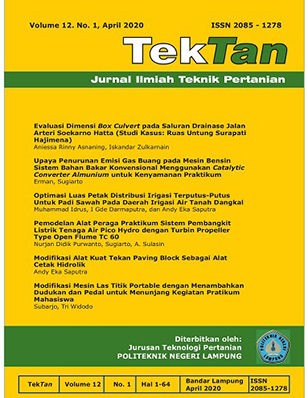Evaluasi Dimensi Box Culvert pada Saluran Drainase Jalan Arteri Soekarno Hatta (Studi Kasus: Ruas Untung Surapati- Hajimena)
DOI:
https://doi.org/10.25181/tektan.v12i1.1674Abstract
Flow system engineering using box culvert had done in arterial road Soekarno Hatta section Untung Surapati-Hajimena, precisely on the Way Kandis river channel. As population growth, on the box culvert’s upstream, had frequently been flooding when it rains with high intensity. It could predict that run off discharge was increased as an impact increasing runoff coefficient due to the growth of the built area in its upstream. It indicated that the box culvert dimension is not suitable to serve runoff discharge. Therefore the evaluation is needed to assess whether the dimension of box culvert was still capable of serving the flowing runoff discharge. The existing box culvert dimension could not serve the runoff discharge in 10, 20, and 25 year return periods are 10.13 m3/s, 11.07 m3/s, dan 11,37 m3/s.It was recommended to use precast concrete (n = 0.03)and 0.015 in slope.The evaluation shown that to serve runoff discharge in 10, 20, and 25 year return period, minimum needed box culvert with dimensions are 1.9 x 1.9 (m), 2.0 x 2.0 (m), and 2.0 x 2.0 (m). Refer to it, then recommended the dimension of box culvert is 2.0 x 2.0 m. It could install more than one with an adjustment dimension if the slope were difficult to reach in the recommended dimension Keywords: river, flood, discharge, box culvert.Downloads
References
Alfieri, L., 2018. A Global Network for Operational Flood Risk Reduction. Environmental Science and Policy 84 (2018) 149-158. Elsevier.
Arrighi C., Pregnolato M., Dawson R. J., Castelli F. 2019. Preparedness Against Mobility Disruption by Floods. Science of The Environment 654 (2019) 1010-1022. Elsevier
Asdak C., Sapian S., Subiyanto. 2018. Watershed Management Strategies for Flood Mitigation: A Case Study of Jakarta’s Flooding. Weather Climates Extremes 21 (2018) 117-122. Elsevier
Budiyanto M. A. 2017. Penelusuran Banjir Sungai Luk Ulo Akibat Perubahan Tutupan Lahan. Jurnal Geografi Volume 14 No.1. Januari 2017. Semarang.
Darsono S., Budieny H., Wahyuningtyas A., Pahlevari E. 2017. Pengendalian Banjir Sungai Bringin Semarang. JURNAL KARYA TEKNIK SIPIL Volume 6 No. 3. Semarang.
Figueroa F., Borrero A. C., Fernandez D. R. 2016. “I like to conserve the forest, but I also like the cash.†Socioeconomic factors influencing the motivation to be engaged in the Mexican Payment for Environmental Services Programme. Elsevier-Journal of Forest Economics. Canada.
Lestari U. S. 2016. Kajian Metode Empiris untuk Menghitung Debit Banjir Sungai Negara di Ruas Kecamatan Sungai Pandan (Alabio). Jurnal POROS TEKNIK Volume 8 No. 2. Desember 2016.
Maulana A. 2016. Memberdayakan Rencana Detail Tata Ruang (RDTR) Kawasan Strategis Hutan Lindung Sungai Wain dan Sungai Manggar Tahun 2015-2035 dalam Mereduksi Ancaman Kelestarian Lingkungan. Jurnal Wilayah dan Lingkungan Volume 4 Nomor 2, Agustus 2016, 123-132. Semarang
Pramono I. B., Putra P. B.. 2017. Tipologi Daerah Aliran Sungai untuk Mitigasi Bencana Banjir di Daerah Aliran Sungai Musi. Jurnal JPPDAS. Nopember 2017. Surakarta.
Pemerintah Republik Indonesia. 2012. Peraturan Pemerintah Nomor 37 Tahun 2012 tentang Pengelolaan Daerah Aliran Sungai (DAS). Kementerian Sekretariat Negara. Jakarta.
Ruitjer J. 2014. Pengelolaan Daerah Aliran Sungai (DAS). World Agroforesty Center. Pidra – Participatory Integrated Development in Rainfed Areas. Jakarta
Zhang G., Pu J., Mao S. 2018. Research of the Flooded and Vent Area of All Flooded High Expansion Foam System. Procedia Engineering 211 (2018) 996-1003. Elsevier



